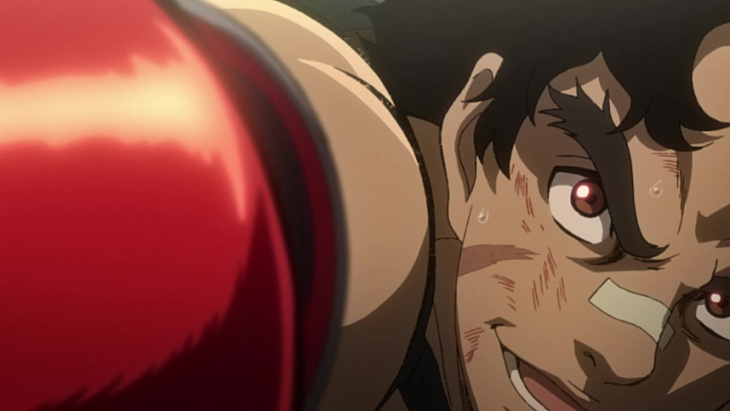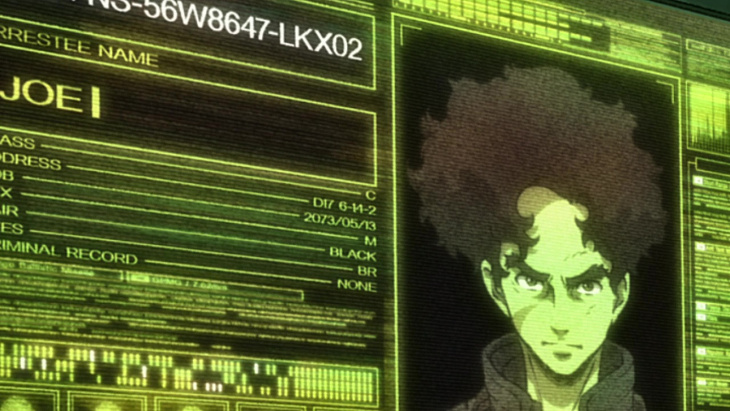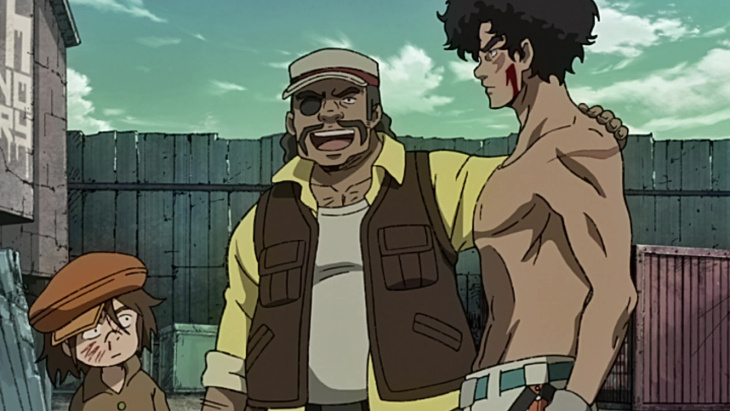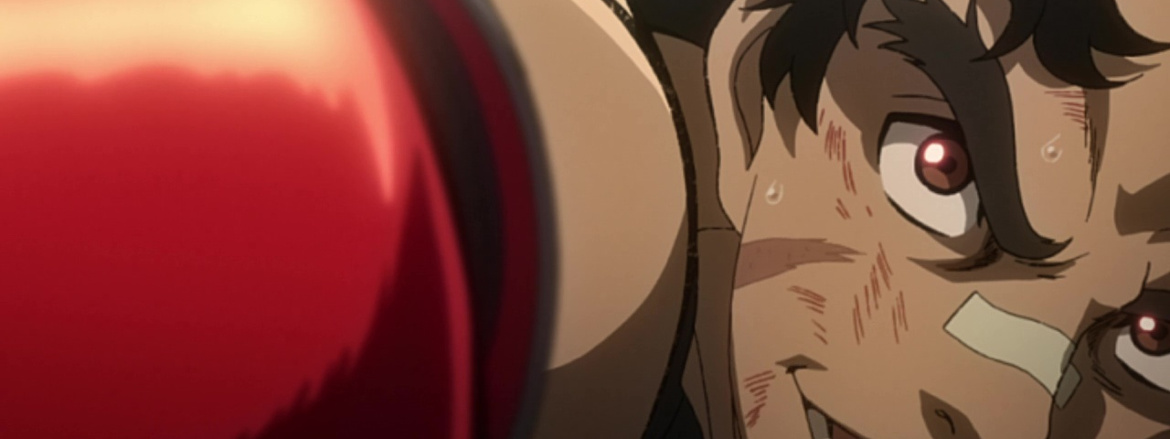
“Yeah, you heard me! You’re getting what you want, you little bastard! We’ve gotta enter Megalonia now! No matter what!”
Despite its unusual setting and tone, Megalo Box is setting itself up to be a notably traditional sports narrative as far as the plot beats are concerned. This is hardly a complaint, since the show handles these tried and true plot beats with a deft hand and plenty of style, and the draw of a sports series isn’t grand narrative twists. Sports anime live and die based on the characters and their interactions, and Megalo Box uses its second and third episodes to expand its cast and develop the key characters that we’ve already been introduced to. However, the strict adherence to the standard sports formula does bring up the question of whether the science-fiction aspect is necessary. As it currently stands, the genre lends a little to these two episodes, but it isn’t hard to imagine this story being stripped of those aspects and not losing anything significant.

The second episode deals primarily with the fight between Yuri and Junk Dog, and grapples with the fallout from it. There isn’t actually that much to the fight, since, for the most part, Yuri walks all over Junk Dog, but the latter does get a small personal victory when he forces Yuri to use his right hand despite claiming he’d abstain from fighting with it in order to provide a handicap. The rest of the episode is devoted to seeing how our protagonist deals with the emotional fallout from the match, and how it sets him inevitably on the path to Megalonia. The end of the episode also marks the most significant reference to Megalo Box’s source material, as, during the forging of his citizenship, Junk Dog takes on the name ‘Joe.’ The third episode goes into Joe’s new training regimen as his manager Nanbu, having found himself stuck in a tricky scenario, commits himself to making Joe a viable contender. We also get to meet a group of orphan thieves who will likely come to serve as Joe’s emotional and technical support. Their introduction serves as one of the clear instances where Megalo Box’s sci-fi leanings are particularly useful, as the orphan Sachio’s mechanical know-how serve to justify him having a continued presence in the narrative. That being said, I’m still irritated by the ‘mechanical mouse’ trick they used to steal cameras at the beginning. As far as I can tell, the con depends on the mark mistaking a clearly metal mouse for a real one. Are metal mice an actual menace in this setting?

Although I was never a massive fan of Watanabe Shinichiro’s work (Cowboy Bebop, Samurai Champloo, Space Dandy), I’ll admit I’ve found myself comparing Megalo Box to Samurai Champloo lately, though this is a little tricky since I’m pretty sure I never watched the latter series in its entirety. Still, between its hip hop inspired soundtrack, fight hungry main character, and characteristic blend of modern and retro, it isn’t hard to envision Megalo Box as a sort of spiritual successor to Champloo. I bring this up because it leaves me questioning how tight a narrative the show will have. Champloo consisted primarily of one-shot episodes, and that is not a favored method of approach for me. Episode three isn’t a one-shot episode since it’s used to introduce new cast members and set up a few plot points that are sure to remain relevant outside of the that particular episode, but it still feels more self-contained than the initial two entries. We’re introduced to a minor antagonist/rival (Who also serves as a Battleship Potemkin reference for… reasons? It’s probably because he’s big.), a conflict is introduced with Sachio at the center of it, and then Sachio and Joe work together to resolve it. Conceptually, there is nothing wrong with this setup, but I’m more a fan of interconnected plotting so I can’t say that this more limited focus worked well for me. The deadline of Joe’s first fight looms over the episode, but it could use a greater sense of presence, and more emphasis could be placed on the stakes. At one point, Nanbu accidentally wrecks Joe’s gear and the response isn’t exactly panicked. They just seem frustrated. Still, this is a sports anime, and those come with a centralized narrative structure built in, so my concerns may be unwarranted. Plus, I am curious to see how they will ultimately overcome their current lack of equipment.
Before I wrap up, a few Notes and Nitpicks:
- The chords that play right after the opening REALLY remind me of OK Computer-era Radiohead. Maybe it’s just me, but due to this I’ve had ‘Paranoid Android’ stuck in my head since I started writing this review. Whenever I hear that bit of music, part of me expects to hear Thom Yorke’s vocals pop in at any moment.
- The designs of the children feel oddly round, given the rough quality of the show’s visuals. It caught me off guard at first, but that passed and the difference may be intentional to emphasize their innocent qualities and make them more endearing. I guess it works better for me than Ed did in Cowboy Bebop, but it was still a sudden shift.
- The kids get paid for their stolen good in “Red Candy”, a type of drug. I’m curious as to what the exact nature and effects of it are, and the episode only shows that it allows for a degree of escapism and invokes a pleasant feeling.
- We get to see the opening starting with episode 2. It’s not a bad one, but it definitely subscribes to a philosophy of “less is more”. The main takeaway for me was that the OP wants to hammer home the parallels between Joe and a pit dog. The rest of the cast is unseen in the opening as we only get allusions to them via snap shots of features associated with them like Nanbu’s cross or Sachio’s hat.




Add comment